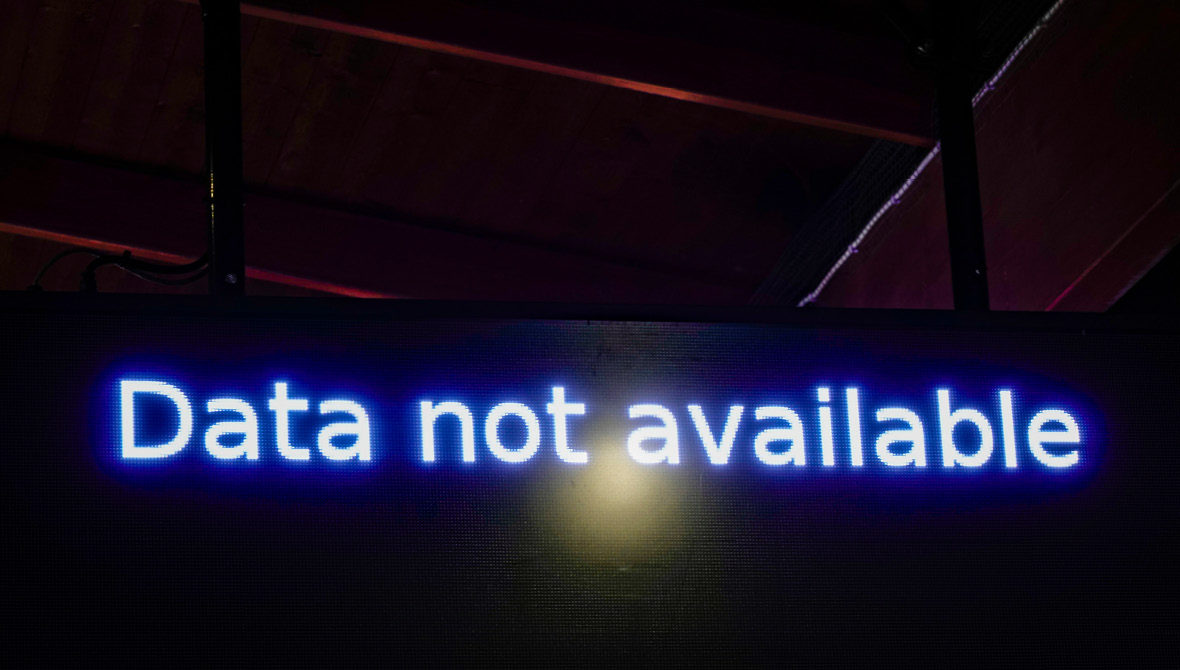IRS Delays and Other Barriers to Data Mean Real Risks for Nonprofits


 This article was first published in our 11 Trends in Philanthropy for 2023 report. Explore all 11 trends in the report.
This article was first published in our 11 Trends in Philanthropy for 2023 report. Explore all 11 trends in the report.
Want the latest trends, research, and more delivered right to your inbox? Subscribe to the Johnson Center email newsletter.
For decades, the nonprofit sector has lagged behind its for-profit and government sector peers across both public and private data sources. Want to know how many car dealers are in your area? Even dating back to the 1980s — 40 years ago! — interested parties could purchase lists from private data providers or access lists of licensed auto dealers from state government sources in both paper and electronic form, and in paper form for multiple prior decades.
Want to know how many private foundations are in your area, or how many nonprofits focus on environmental issues? Good luck. Unless you have a massive computer system or are willing to pay hundreds or thousands of dollars for extracts from a very small number of providers, it is just as difficult to answer these questions today as it was in the 1980s.
To date, progress has been slow but steady. While the Foundation Center started publishing data in print about private foundations across the nation in 1960 (Enterline Fekeci, n.d.), it wasn’t until the early 1980s that a similar effort cataloged data on nonprofits: the National Center for Charitable Statistics (NCCS) was created as a research division of Independent Sector in 1982 (Urban Institute, 1999).
“[M]ost initiatives that track philanthropic data are both the only source of the information they provide and rely heavily on grants and foundation funding to continue. When research teams, centers, or funding disappears, data sets and analysis often do, too.”
Guidestar, a website founded in 1994, released a searchable electronic database of nonprofits with limited financial data in 1996, making that information available to anyone with internet access (Carnegie Corporation of New York, 2005). Charity Navigator, a free nonprofit evaluating service, followed a few years later in 2001 (n.d.). It would take another 15 years — and a federal lawsuit — for the IRS to release complete Forms 990 (the annual tax returns filed by charities) in raw form en masse in 2016 (Howard).
However, the progress we have made in understanding and using nonprofit sector data since 2016, through the efforts of a small but growing number of researchers, networks, and policymakers is increasingly on shaky ground. While basic 990 data is now widely and freely available, their work is shining a light on how much other data is still missing about the sector.
Making matters worse are the pandemic-related delays in the processing and release of Form 990 returns by the IRS. If the paucity of data continues, it will have severe consequences for the nonprofit sector and its mission-driven work.
The flood of electronic 990 data that hit the sector in the 2010s created a wave of innovation in data access. Dozens of university researchers, nonprofit and for-profit entrepreneurs, and journalists created and enhanced charity search and information sites, such as Cause IQ (launched in 2014), The Accountability Project at American University (established in 2019), CitizenAudit.org, and Grantmakers.io.
These innovators contributed to the positive part of this trend: with access to the raw Form 990 series information directly from the IRS, many data actors were able to create websites and publications, drawing attention to the available data. The nonprofit sector needed this basic, 990-based data to create and share actionable knowledge at scale and with organizations of all sizes.
Prior to 2016, most of the national lists of nonprofits were based on extracts of a limited number of fields from the actual IRS Form 990 records. After the IRS began publishing the full 990s in electronic format, every field on the 990s became accessible electronically, unlocking detailed information about financial audits, policies and procedures, and free-response text questions that were essentially inaccessible before.
These providers and reports started with basic information about nonprofits: “How many nonprofits are there?”, “Where are they located?”, and, over time, moved into investigative journalism, advocacy, and benchmarking purposes (e.g., “Is our endowment larger or smaller than other foundations with similar missions?”, and “How does our payout rate compare to our peers?”).
The tools and platforms now predominantly exist to make nonprofit sector data more accessible and useful to everyone. However, our progress as a field is under threat, primarily due to mounting delays in the IRS’ release of the most recent batches of Forms 990.
Prior to 2020, nonprofits already experienced a 14- to 18-month delay between when they filed their Form 990 (due approximately five months after the close of a fiscal year) and when the IRS was able to fully process and release it to the public. However, due to inadequate staffing and resources within the IRS itself, and the aftermath of the pandemic, additional delays are mounting. In September 2022, Candid reported that for 990s filed for tax year 2019 and later, the processing delay for most organizations is now well over 36 months (Clerkin & Koob).
This lengthening delay, the limitations of the Form 990 itself, and other challenges in our data ecosystem highlight critical gaps in our knowledge that are only worsening as time goes by.
Forms 990 are primarily financial forms, so detailed information about nonprofit service areas or populations of interest is missing or woefully inadequate. For example, 990s cannot tell us whether a nonprofit operates in a single location or many locations, nor what populations the nonprofit serves.
Many federally collected data sets do not collect, or report, data on nonprofit organizations. All state labor departments, as well as the federal government, report on both employment and unemployment by industrial sector on a monthly or quarterly basis. However, nonprofit employment is not broken out as a separate sector in these regular reports. This creates a massive hole in nonprofit data — one of the largest sectors of the economy.
However, most initiatives1 that track philanthropic data are both the only source of the information they provide and rely heavily on grants and foundation funding to continue. When research teams, centers, or funding disappears, data sets and analysis often do, too.
And in the end, all of these efforts rely first and foremost on the availability of up-to-date data. Open990.org closed in late 2022, citing the lack of that data as its “most urgent issue” (para. 3). The site’s 170,000 monthly web visitors will now have to look elsewhere to find the information they need, and the public has lost one of the providers of easily accessible nonprofit data.
In late 2022, organizations called upon the IRS to seek the resources necessary to clear the backlog and improve and expand overall reporting on the nonprofit sector. These organizations included:
the National Association of State Charity Officials,
the IRS Advisory Council, and
At the same time, myriad efforts exist across the sector to expand and improve how we hold and make accessible our own data (see, for example, the GivingTuesday Data Commons, n.d., and the Johnson Center’s compiled Use Cases from Publicly Available IRS Form 990 Data, 2022). As we enter 2023, the future is unclear.
Staff, donors, clients, and policymakers alike expect to be able to find as much information about a foundation or nonprofit from their phone as they can about a car or a vacation destination — and as a sector, philanthropy remains light years behind its peers.
_______________
1 See “Appendix A: U.S. Databases on Philanthropy” for more information. https://www.dropbox.com/s/sbpym1z9neafbf3/generosity-commission-data-appendix.pdf?dl=0


Aspen Institute. (2022, November). Final comments to IRS Form 990 series. https://drive.google.com/file/d/1NmujvX4lsDjcQqbHDzxP2oAdBqcVVlON/view
Blackbaud Institute. (2022). Celebrating 10 years. The Blackbaud Institute Index. https://institute.blackbaud.com/the-blackbaud-institute-index/
Carnegie Corporation of New York. (Winter 2005). GuideStar: Data about nonprofits goes online. Carnegie Results. https://web.archive.org/web/20110721065059/http://carnegie.org/fileadmin/Media/Publications/GuideStar_Data_About_Nonprofits_Goes_Online.pdf
Charity Navigator. (n.d.) About us. https://www.charitynavigator.org/about-us/
Clerkin, C., & Koob, A. (2022, September 26). The data/crisis catch-22: How the pandemic created a social sector data gap. Candid. https://blog.candid.org/post/the-data-crisis-catch-22-how-the-pandemic-created-a-social-sector-data-gap/
Dorothy A. Johnson Center for Philanthropy. (2022, April 6). Use cases from publicly available IRS Form 990 data. https://johnsoncenter.org/resource/use-cases-from-publicly-available-990-data/
Fekeci, E. (n.d.). Foundation Center and GuideStar join forces to become a new nonprofit entity named Candid. Candid. https://candid.org/about/press-room/releases/foundation-center-and-guidestar-join-forces-to-become-a-new-nonprofit-entity-named-candid
Fundraising Effectiveness Project. (2022). The Fundraising Effectiveness Project. AFP. https://afpglobal.org/FundraisingEffectivenessProject
GivingTuesday Data Commons. (n.d.). What is the Data Commons? https://data.givingtuesday.org/about
Giving USA. (2022). Giving USA 2022 now available. https://givingusa.org
Howard, A. (2016, June 16). IRS opens up Form 990 data, ushering nonprofit sector into the age of transparency. Sunlight Foundation. https://sunlightfoundation.com/2016/06/16/irs-opens-up-form-990-data-ushering-nonprofit-sector-into-the-age-of-transparency/
IRS. (2022, November). Internal Revenue Service Advisory Council Public Report. https://www.irs.gov/pub/irs-pdf/p5316.pdf
National Association of State Charity Officials. (2022, November 28). NASCO comments regarding OMB Control No. 1545-0047. https://www.nasconet.org/wp-content/uploads/2022/11/2022-11-28-NASCO-Board-Comments-to-IRS-re-forms.pdf
Urban Institute. (1999, October 18). Financial disclosures by charities now on the internet. https://webarchive.urban.org/publications/900054.html